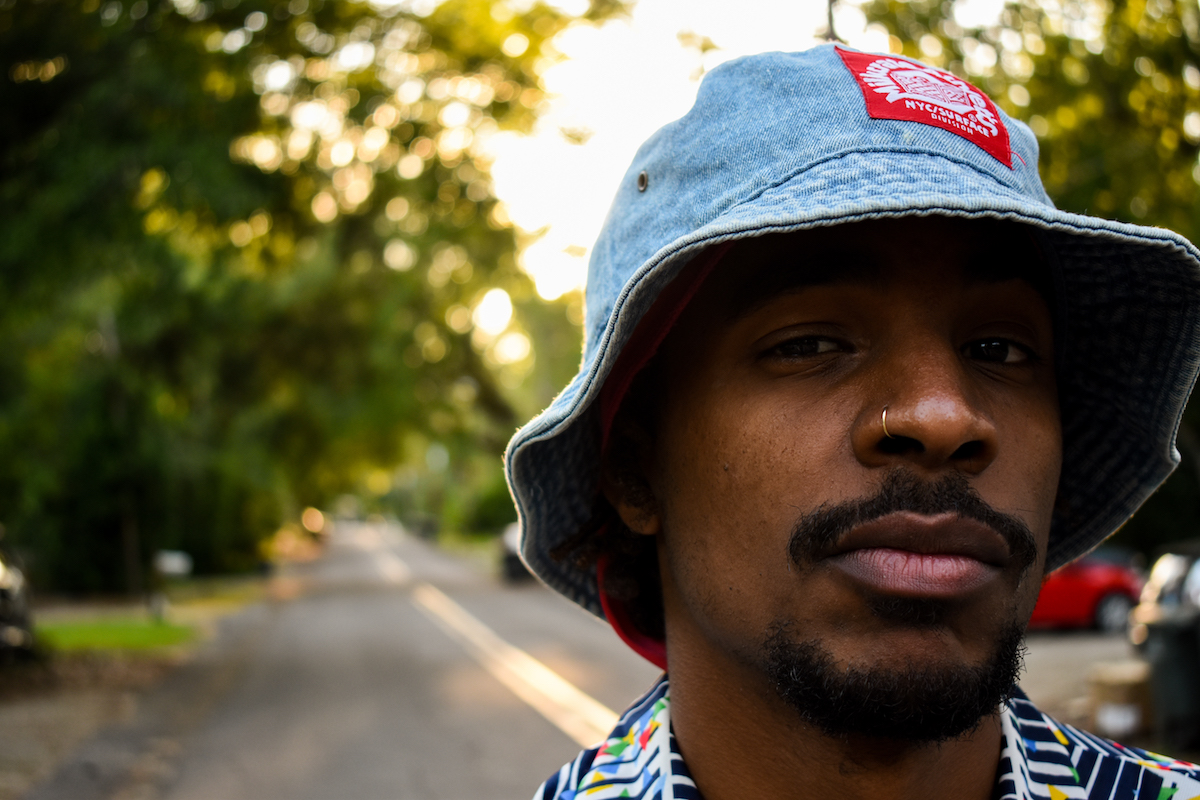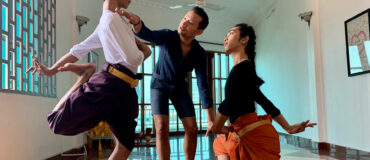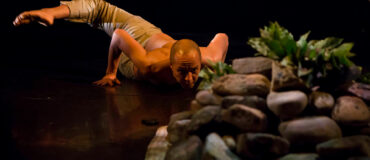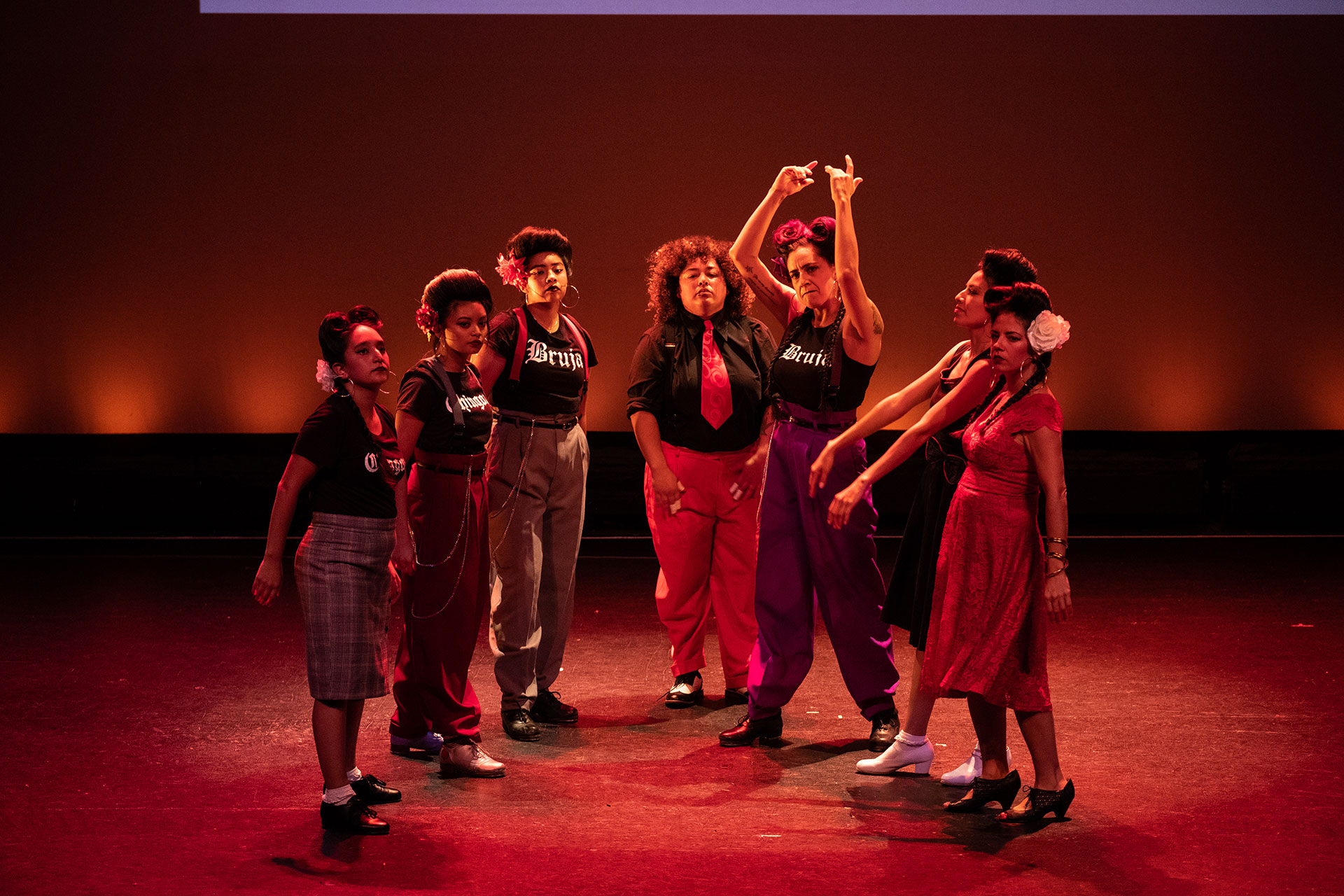Justice in the Movement:
Robert Gilliam, Sarah Crowell, and MurdaMommy
By Jeremy Guyton
Editor’s note: This article is one of 11 in a series examining the creative work of 31 dance artists funded by Dance/USA Fellowship to Artists, generously supported by the Doris Duke Charitable Foundation. These artists’ practices are embedded in social change as they work in multiple dance forms in communities across the country.
The other morning, while scrolling through my social media feed, I came across four images visualizing the evolution from inequality to justice through the metaphorical use of two children attempting to pick apples from opposing sides of an apple tree. The first image, entitled “Inequality,” shows the tree bent sideways toward one of the children with an apple falling, while the other child looks up, perplexed and empty handed. In the second image, titled “Equality?” the children stand on ladders, which allows them to reach the tree, but one child still has an advantage because the tree bends toward that child. In the third image, titled “Equity,” the child who had the disadvantage now has a taller ladder, but the tree remains bent, so that child still has access to fewer apples. Finally, in the image marked “Justice,” the tree itself has been propped up and straightened, so both children can reach the tree and all the apples with the same sized ladder.
While current conversations center equity in our societal structure, I am drawn to this visual assertion that the most optimal outcome is restructuring the tree, or justice on a radical scale. It is also a sobering reminder that this work will take time and extensive labor to ensure all our great-grandchildren have access to this sweet fruit. In speaking with dance artists Robert Gilliam, Sarah Crowell, and MurdaMommy — three Dance/USA Artist Fellows — it becomes evident that dance holds the powerful potential to accelerate us all toward a just world.
DANCE AS CONNECTION: ROBERT GILLIAM
“I wanted to get artists of color and take them to these white communities, and hit them with it hard and like here we are. Let’s do it.” — Robert Gilliam
Sitting with Robert Gilliam in his Culver City, Calif., studio, he remarked that his interest in dance ignited when his uncle returned from a deployment in Vietnam. Navigating re-entry into civilian life, his uncle would hit the bottle in the evenings, eventually succumbing to the urges to groove through his PTSD. Gilliam and his uncle would spend hours dancing together, with his uncle teaching him social dances at their family house in Watts, a predominantly Black, working class neighborhood in South L.A. This experience connected him to his uncle in a way nothing else could, and it maintained the pulse of his family. Through dance, Gilliam built a relationship with his uncle even as he saw his uncle battle the effects of poor governmental support for Vietnam veterans once at home on American soil. Dance filled the gap when institutions failed.

Gillam provides high-quality K-12 dance instruction to students in the Los Angeles area through The Artist Collective, which connects teaching artists and students from across socioeconomic backgrounds. Dancing together, students and teachers share moves and unlearn harmful stereotypes. Courtesy: R. Gilliam
For more than ten years, Gilliam has provided high-quality K-12 dance instruction to students in the Los Angeles area through the non-profit he founded, The Artist Collective. He illustrates the depth of connection fostered between teaching artists and students, noting that one teaching artist spent a holiday vacation in Hawai’i with a student’s family. Most teachers are krumpers and hip-hop artists from South L.A., who teach in schools in higher socioeconomic areas, like Santa Monica and Palos Verdes. The Artist Collective’s mission is utilizing dance instruction as a vehicle to build a space for justice thinking. Through dancing together, students and teaching artists unlearn the harmful fallacies and stereotypes designed to divide, oppress, and strip away our collective humanity. Through embodied experiences in the classroom, participants cultivate a foundation of mutual respect, understanding, and love in which justice takes root.
This work takes Gilliam full circle: “When I grew up in Watts, it was the height of the crack situation. You know, we didn’t really go out too much. I often tell the story of how, until I was in high school, I didn’t even come over to Santa Monica or the beach.” Now, as an adult, he uses his passion for dance as a powerful tool to expand opportunity and foster deep connection in dancers in his community. During the recent Black Lives Matter uprisings, he noted that affluent white students held marches in their communities in Palos Verdes. He also knew, deep inside, that his classes and the presence of teaching artists from The Artist Collective played a direct role in building white accompliceship in the fight toward racial justice.
Gilliam understands quite intimately the capacity and power of dance to connect despite communication barriers. On a 2004 tour in China, Robert mentioned that he once approached a studio in which a Chinese ballet dancer was stretching and warming up. He observed her warm-up, before receiving permission to share the space with her. He recalled how they started dancing together, without ever verbally communicating. The vulnerability and trust he found in this offstage duet highlight how movement captures what words and verbal language cannot. Dance, Gilliam’s anecdote illuminates, allows us to connect across cultural and social lineages and forge bonds that breed empathy and compassion.
DANCE AS HEALING: SARAH CROWELL
“That’s what I’m here to do with these kids — teach them how to love themselves. And what I discovered very quickly after that is that you can’t teach someone how to love themselves. You need to love yourself and be around people and do the thing that you love.” — Sarah Crowell

Founded in 1988 by Sarah Crowell, Kate Hobbs and Anthony Daniels, Destiny Arts Center in Oakland, Calif., aims to develop peaceful, powerful and creative young people through performing arts, martial arts, youth leadership and self-defense programs for 3 to 18 year olds. Photo: Kerry Kehoe
Sarah Crowell has dedicated both her personal and professional dance life to uncovering the healing properties of the form. Spending almost 30 years as artistic director of Destiny Arts Youth Performance Company in Oakland, Calif., Crowell described dance as a “kinesthetic expression for releasing trauma.” She revealed that, as she stepped into her fullest, most authentic self as a dancer, performer, and educator, she saw this authenticity reflected in her students as they were empowered to cultivate love within themselves. As a Black, biracial, queer woman, Crowell notes that trauma lives deep within her body and that dance has enabled her to access love and self-worth in ways that have inspired similar processes throughout her community. After a debrief of a somatic exploration exercise with her students, a youth reflected on embodying bliss. The youngsters emphasized that the process of stepping into an aspirational embodied state expands possibilities and provides a blueprint for planning and building a future world that has the capacity to hold all of our wants and needs.

Rashidi Omari and Crowell (right), co-artistic directors of Destiny Arts Youth Performance Company (DAYPC), with students from DAYPC and the Destiny Junior Company after a performance of Jewels, in Oakland, Calif. Photo: Kerry Kehoe
Dance, in its unfiltered form, offers a pathway to healing according to Crowell. As we discussed The Black (W)hole, Destiny Arts’ current project creating ritual to memorialize youth who have been killed in Oakland, Crowell offered a story of one collaborator’s child that had me feeling all warm and fuzzy inside. This parent, an activist, was puzzled that their child was not interested in attending a recent protest organized by one of Crowell’s students because he was “blissed out.” While concerned at first, Crowell and her colleague soon arrived at the epiphany that he didn’t need to protest because he didn’t feel that level of oppression in his body. This notion vibrated deeply within my core as I meditated on both the work of our ancestors and the work that we have done in this current moment in manifesting an environment in which our youth savor the fruits of freedom and liberation within their bodies.
DANCE AS JUSTICE: MURDAMOMMY
“Footworking is the third dimensional representation of the frequency vibrating inside your body.” — MurdaMommy
.jpeg)
A dancer, choreographer, master teacher, musician, actor and video game developer, MurdaMommy harnesses her entrepreneurial spirit to spread the gospel of Chicago footworking beyond its hometown roots. During the COVID-19 pandemic, she conducted virtual classes from her living room. Photo: Jason Pinkney
MurdaMommy, Chicago’s “Queen of Footwork,” uses the power of dance to foster justice within her community. She captures the essence of that magic embedded in movement. Through her work mentoring young dancers in her community and developing a video game, named “JukeTown,” she shares the history and culture of Chicago footworking, a dance form emerging out of dance battles and juke parties, with accompanying 160 beats-per-minute music and nuanced stylings informed by the neighborhood in which it is practiced. MurdaMommy employs this native Chicago dance style to foster body ownership and agency in young students. In reference to school, MurdaMommy explains that most institutions implement rules to “tell me about my body, but not how to use my body.”
MurdaMommy intimately understands the relationship between music and movement fueling the necessary energy release for young people who carry the burdens, stress, and energies of a system designed to fail them. Footworking provides an outlet that protects, heals, and liberates. Through mentorship and partnership with non-profits serving the most vulnerable margins of our community, MurdaMommy is on a mission to revitalize footworking in her community.
MurdaMommy began footworking seriously at 15, when a friend started teaching its basic moves to her during breaks in high school. Her interest in the form quickly grew and she began immersing herself in its culture, attending events and teaching herself vocabulary to enhance her footworking style. Dancing provided MurdaMommy a positive outlet, a sense of purpose and — after release from prison in 2014 with acquittal and exoneration of all charges — a vehicle through which she has been mentoring and healing her community. Currently, she hosts donation-based technique classes online using Zoom; the donations are directed to a food drive and personal protective equipment to support her Chicago South Side community amid the current COVID-19 pandemic, which disproportionately impacts Black communities and communities experiencing poverty.

MurdaMommy’s first taste of Chicago footworking came at neighborhood juke parties and the oldest continuous African American parade — the Bud Billiken Parade. With uptempo beats and high-octane movement concentrated in the feet and legs, MurdaMommy uses footworking to assuage stress, sorrow and anger. Photo: Jason Pinkney
Multiple times throughout our interview, she stated, “Footwork saves lives.” MurdaMommy offered examples of the role of the footworker as a peacemaker and mediator in the community; if an altercation is brewing or police show up to an event, footworkers immediately begin dancing, placing their bodies on the frontlines to elevate the energy and protect their community from state-sanctioned violence. Footwork, she said, literally saves lives.
MurdaMommy’s work illuminates the capacity of dance to build structures rooted in justice for Black communities. Through footworking, a night’s trajectory can be altered and a life protected by intentionally harnessing the vibratory energy within and around the community and infusing joy and positivity into otherwise precarious situations. As I sat in my kitchen, interviewing MurdaMommy, with George Floyd’s televised funeral faintly broadcasting in the living room, she shared a crucial observation:
“I think what I and the rest of the pioneers and elders within this community …. I think we been doing this before the pandemic because we were already living in a pandemic. We already didn’t have anything. We already didn’t have equality. We already didn’t have no money. We already didn’t have opportunities. So to say we have to rebuild after this pandemic is not true. We been rebuilding …. We’re not going through a pandemic. Our culture is not declining …. It’s rising.”

Jeremy Guyton is an alchemist, dreamer, and new world conjurer. Born and raised a first-generation Angeleno, he first learned to tell stories through his body. Upon graduation from high school, curiosity led him to the Mid-Atlantic, where he studied theater at Georgetown University. He also honed the flick of his pen, writing poetry and monologues. In 2012, Guyton landed in New Orleans and immersed in the vocabulary of second-line footwork and bounce. He continued to code switch, writing grants and strategy reports as a means of sustenance, while feeding his inner child through scattered sketches and drafts. After seven years, a life’s cycle, he is pursuing an MFA in choreography and performance at Florida State University.
Please visit the artists’ websites: Sarah Crowell, Robert Gilliam, and MurdaMommy. Readers may read and print a PDF version of this article here. Readers may visit and share this article on Medium here. Find more information on the DFA Article Series here and more information on Dance/USA Fellowships to artists here.
____
We accept submissions on topics relevant to the field: advocacy, artistic issues, arts policy, community building, development, employment, engagement, touring, and other topics that deal with the business of dance. We cannot publish criticism, single-company season announcements, and single-company or single artist profiles. Additionally, we welcome feedback on articles. If you have a topic that you would like to see addressed or feedback, please contact communications@danceusa.org.
Disclaimer: Opinions expressed in guest posts do not necessarily represent the viewpoints of Dance/USA.





